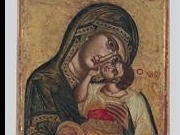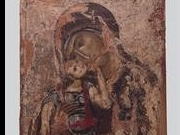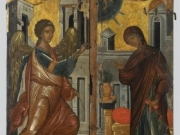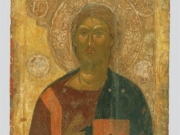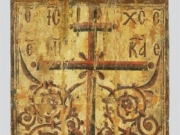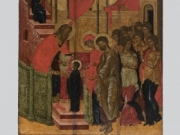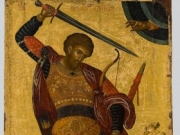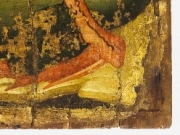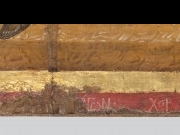Icon & Woodcarving Conservation Workshop
History
The Museum has a portable icon conservation tradition stretching back to the very start of the 20th century. When the BCM was founded, icons and wood carvings that had been worshipped in churches or kept in private collections for many years found themselves in its collections. That they were in need of conservation became immediately clear: suffering the wear and tear of continual use beside oil lamps and candles, as is usual in Orthodox worship, most of the icons were covered in a thick layer of soot and other deposits.
The first ‘restorers/repairers’, who were reputable artists and icon painters of the time, undertook to make the icons beautiful again. They cleaned them, filled-in any sections missing from the painted surface in the style of the original, and sometimes even committed forgery, adding the signatures of celebrated icon painters of the past.
Conservation efforts intensified after World War Two, when there was also a marked change in the conservators’ professional ethics and aims. However, it was the return of the first two academically-trained Greek icon and wall painting conservators from studies in Italy in the 1960s that ushered in a new era of conservation at the BCM. Tasos Margaritof, followed shortly afterward by Stavros Baltogiannis, set up the icon conservation workshop, opened the Museum’s photographic and woodcrafts department, and dedicated themselves to the struggle to meet the ever-increasing need to conserve painted works both at the BCM and outside it, in Mount Athos, Saint Catherine’s monastery in Sinai and elsewhere.
Thanks to their efforts, a systematic scientific approach to conservation became the norm at the BCM, where traditional methods were replaced inter alia by a thorough initial examination, the use – albeit on a limited scale – of stereomicroscopes, photographic diagnostic techniques and the use of X-ray techniques. At the same time, the workshop began to keep detailed records of all its conservation projects in the late 1970s.
The two conservators also taught at the Antiquities Conservators Training School which the Museum ran between 1969 and 1971 in an effort to cover the education gap then present in Greece. Their vast experience and skill at conveying it to their students helped produce the new generation of conservators active in the 1970s and 1980s.
Conservation
The icon and wood carving conservation workshop, the oldest of the BCM’s workshops and the largest in staffing terms, has continued to develop and to handle and care for one of the Museum’s largest and most important collections.
The workshop’s new approach to icon conservation on both a practical and professional level, combined with the new techniques and materials at its disposal, led to a number of ‘discoveries’ after 1960 that would impact on the subsequent study of icons and lead to experts taking a fresh look at a number of well-known works.
Older layers beneath the painted surface came to light using the detachment method. Overpainting has been removed, allowing forgeries to be spotted or revealing the signatures of celebrated icon painters, and in many cases leading to a radical reassessment of many icons’ dating.
The new practices and professionalism that have imbued the activities of the icon workshop over the past three decades are informed by respect for the authenticity of a work and a commitment to non-invasive interventions and to the use of reversible materials and techniques. In recent years, another important change has been the emphasis on documenting conservation projects and research. The old methods have thus given way to a more precise, controlled and – above all – scientifically-documented modus operandi. The workshop’s commitment to continued research has also led to its participation in two highly significant European programmes: diARTgnosis and LASTOR.
The workshop’s goals for the years to come are to lay the foundations, and intensify efforts, for the conducting of further research into the BCM’s icons. The workshop’s conservators will be amassing, processing and drawing conclusions from the archive containing details on all its activities since its foundation. They will also be completing work on the specialist databases containing information on individual icons, their ideal climatic conditions and the conservation materials and methods to which they have been subjected to date. The database will allow the icons’ behaviour to be studied over time; by permitting the efficacy of previous conservation efforts to be assessed, it will also allow conservators to maximize the effectiveness of the methods in their conservation armoury.








